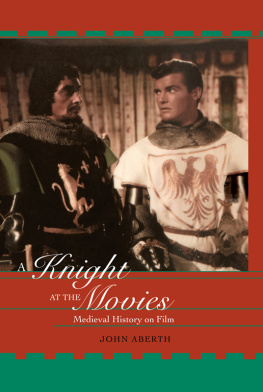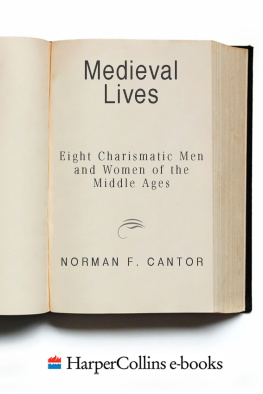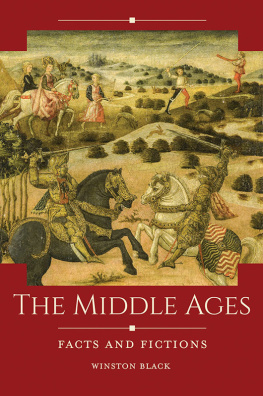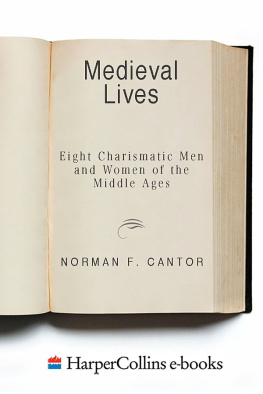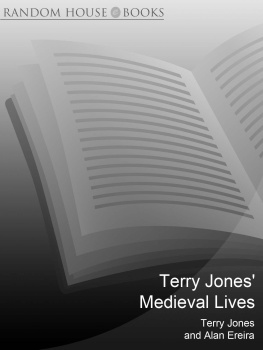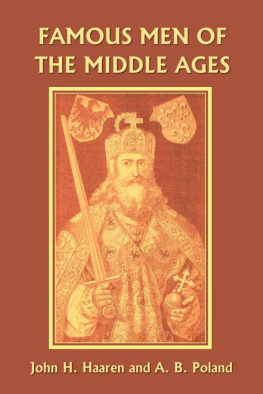Published in 1993 by
Routledge
711 Third Avenue,
New York, NY 10017
www.routledge-ny.com
Published in Great Britain by
Routledge
2 Park Square, Milton Park
Abingdon, Oxon, OX14 4RN
www.routledge.co.uk
Copyright 1993 by the American Film Institute
Routledge is an imprint of the Taylor & Francis Group.
All rights reserved. No part of this book may be reprinted or reproduced or utilized in any form or by any electronic, mechanical or other means, now known or hereafter invented, including photocopying and recording or in any information storage or retrieval system, without permission in writing from the publisher.
Library of Congress Cataloguing-in-Publication Data.
Aberth, John.
A knight at the movies : medieval history on film/by John Aberth
p. cm.
Includes bibliographical references and index.
ISBN 0415938856 (hardback : alk. paper) ISBN 0415938864 (pbk. : alk. paper)
1. Middle Ages in motion pictures. I. Title.
PN1995.9.M52A24 2003
Publishers Note
The publisher has gone to great lengths to ensure the quality of this reprint but points out that some imperfections in the original may be apparent.
Prologue
There is a scene about a third of the way into the film, Monty Python and the Holy Grail (1975), in which a famous historian appears on the screen to comment on the action thus far. Suddenly, from out of nowhere, rides a sword-wielding knight who cuts down the historian in midsentence. Monty Pythons historically irreverent antics now can proceed without further interruption that is, until the long arm of the law catches up with the troupe just as the film is about to climax with the storming of Castle Arggh! No doubt there are many more filmmakers who wish that they could do the same to the historians and critics who dissect their creations.
Unfortunately, when it comes to portraying the Middle Ages, that period of European history roughly between 500 and 1500 A.D., far too many targets present themselves. Who can resist ridiculing The Black Knight (1954), a film in which sixth-century Arthurian warriors gallop across the plain while in the distance can be distinctly seen twentieth-century telephone poles? Or how about The Black Shield of Falworth (1954), in which Tony Curtis, summoning up his best medieval Bronx accent, utters the immortal line, Yonda is the castle of my fodda?
To be fair, the Middle Ages is perhaps one of the most difficult eras of history for modern audiences, as well as their cinematic entertainers, to imagine. On a superficial level, we are served up stories of knights in shining armor rescuing damsels in distress, or very contradictory images of barbaric cruelty and superstitious ignorance. Of course, neither extreme can hardly begin to communicate the experience of what it was like to live during the Middle Ages. To penetrate the medieval mentality, one must engage, at least in part, a whole different set of assumptions and way of looking at the world than our own. This was a time when the West was dominated by the Catholic Church and its religious ethos, when society was divided into rigid hierarchies of knight, priest, and peasant, and when men and women, even in towns, lived in a very intimate relationship with their natural surroundings and with each other in their communities. Yet medieval people were also human beings, just like us: they lived and died, loved and suffered, worked and played. They are our ancestors, but also strangers to our modern culture, with its fast-paced technology and increasingly multicultural, global outlook.
Despite this, some movies about the Middle Ages, such as Carl Theodor Dreyers The Passion of Joan of Arc (1928) or Ingmar Bergmans The Seventh Seal (1957), must rank among the best and most thought-provoking films in cinematic history. They have achieved this by reveling in the differences between those times and our own and by drawing us into another world in order to better understand and appreciate those differences. All this takes a high degree of imagination and empathy with the past, while at the same time suggesting parallels with the present.
Obviously, movies, even if they are based on real historical events, must be evaluated differently than scholarly books. Rather than trying to educate us as to what really happened, the main goal of cinema is to entertain. It cannot hope, and does not aspire, to achieve the accuracy and comprehensiveness of historical works. Except for some experimental, avant-garde films, a creative narrative cannot allow alternative points of view, cite sources, or utilize a critical methodology. If screenwriters and directors attempted to be ruthlessly historical, their products undoubtedly would be commercial, not to mention artistic, failures.
Nevertheless, movies have taken their place in historians classrooms, and for some time now have been discussed or reviewed in the pages of the professions most distinguished journals. There is some unease about this. A fellow medievalist, David Herlihy, has argued that films should not be an integral part of historians teaching or scholarly scrutiny. Herlihys main objection is that movies create a make-believe world where viewers are required to suspend their critical judgment and accept the illusion that they are eyewitnesses to past events occurring in the present. The suspension of rational thought that cinemas magic requires, Herlihy argues, is not conducive to the historians task.
It is taken as a given in this book that cinema neither can nor ought to take the place of historical scholarship. But it would be foolhardy of historians to neglect this medium altogether. For, like it or not, many people, including our students, get their history from such popular sources. Indeed, the common currency of recognition that films provide can be put to the historians use in a way that I think Herlihy has overlooked. Medievalism is generally defined as the study of the many ways in which modern society and its popular culture interacts with, interprets, and both influences and is influenced by the actual history of the Middle Ages. As such, medievalism can be viewed as a subset of historiography, the science of determining how history is written, by historians and others. Movies provide an exciting and engaging method of illustrating this complex process to students in the classroom and to the public at large. In making a film, the filmmaker, sometimes with the historian acting as consultant, invariably reflects the current mode of how society wishes to remember its ancestors. Used in this way, film provides historians with a powerful tool for demonstrating the connections to be made between the medieval and the modern.
What is more, it is a little unfair to bring the creative arts to the bar, as Herlihy does, of the high court of historical criticism. An historian more sympathetic to film, Robert Rosenstone, has pointed out that cinema, unlike written history, depends on fiction and invention in order to tell a linear narrative that audiences can follow up on the screen. Therefore, movies occupy a world apart from the historical, and if historians trespass on that realm, they should acknowledge the different rules of the game. This does not mean that films and their makers should be held unaccountable, but that their possibilities, as well as their limitations, be recognized. Herlihy was gracious enough to admit that films have the advantage in bringing the past to life through their vivid visual textures. Images on the screen can collectively create an atmosphere or mood that captures the spirit of the times. But there is yet another consideration to be made in the cinematic mediums favor that Herlihy may have missed. Movies, freed from the necessity of proof, can dare to speculate on past imponderables that scholarly conventions would not abide. Did Joan of Arc want to die? Did medieval couples, fettered by arranged marriages, ever marry for love? What did it feel like to face the onslaught of the Black Death? Was Richard the Lionheart gay? These are perhaps more mundane questions than scholars are used to asking, but nevertheless, people interested in history want them answered.

